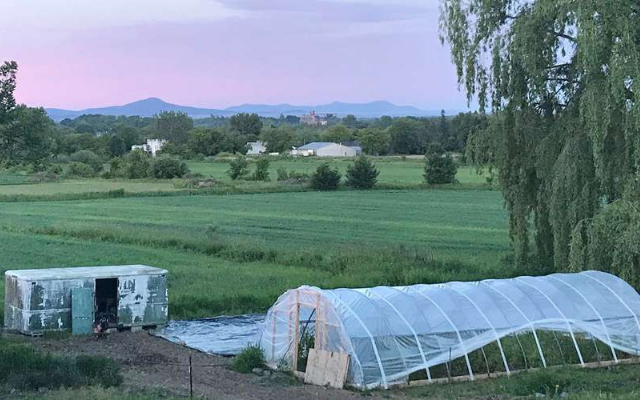Growing fruits and vegetables all year round in the colder parts of North America would be wonderful but, the climate limits the growing months to the summer.
And even that would be in the balmier areas of the country; at high altitudes and further north, it becomes more difficult to grow produce without a greenhouse.
There are two main types of greenhouses to consider - those attached to a home and accessed by an interior door (which can also be used as a solarium), and free-standing greenhouses that are intended primarily for cultivating plants and food.
Three greenhouse owners shared their construction methods and experiences for building greenhouses in cold climates where the benefits accumulate for food production.
Pierre Fisette built his passive solar greenhouse by himself after extensive internet research and attending workshops. He began with existing greenhouse plans and adapted them to meet his specific needs & the needs of a cold climate.
Greenhouse Construction:
The building is wood-framed, 20’ x 40’ and 16 feet high inside. The north wall is buried about 6 feet deep and made with 310 old tires that are filled with sand. The three other sides allow light in, plus the south-facing roof. The north roof is metal.
- Rigid insulation was used below the floor and on the north wall.
- Glazing is a mix of polyethylene, patio doors and reclaimed windows.
For greenhouse's in a kit form online with delivery, or greenhouse construction materials you can look here.
Ventilation:
At this moment, two small fans provide the necessary fresh air and moisture removal. The installation of a ventilation system powered by solar panels is planned for the future.
Growing season: At present, it is used for a little over three seasons; there are about 2-3 months where it is not currently in use. Pierre plans to add a rocket stove and geothermal heating system in the future to extend the growing period to a full four seasons.
Type of crop & yield:
No special soil was used, and it is fortified using only organic or natural fertilizer. The crop includes an assortment of greens and vegetables such as tomatoes, cucumbers, peppers, snow peas, swiss chard, kale, herbs, etc.
"Our goal is to become self-sufficient, at least as much as possible. I could grow enough to provide for several families if I wanted, but our original goal was not to make a living with it," said Pierre.
Their household has two people, but this cold climate greenhouse also helps feed four children, grandchildren and step-parents. "We give a lot of it away, and this year we began to sell some in the local village. Selling surplus helps us continue to finance the project.”
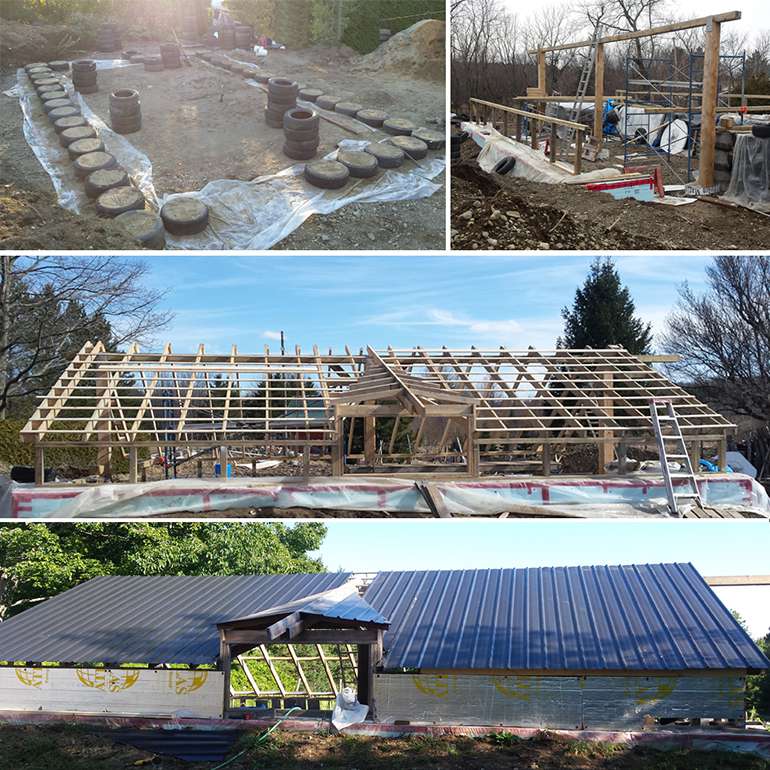
Total material cost:
About $3,000 to date. The cost was kept to a minimum through the use of many recycled, salvaged and traded building materials, though Pierre expects that total to go up with the additions he has planned for the future.
Level of satisfaction:
Very satisfied. "There will always be surprises and shortcomings in a crazy project like this," he says with a laugh, "but we're taking care of them one problem at a time."
“We would eventually like to add walls made of old bottles. This is about more than just food, it is also an artistic project”. Both he and his partner are artists and avid recyclers.
And on achieving his goals of self-sufficiency, he says, "We have not had to buy vegetables since the start of May. We don’t eat much meat, and the meat we do consume comes from a local organic producer."
Pierre expects to achieve 100% self-sufficiency in terms of fruits and vegetables within 5 years, which is a fabulous result for a cold climate greenhouse.
His recommendations to others:
- Buy an existing metal structure to simplify the build!
- Be very mindful of moisture levels- it is important to avoid having plants that are soaked in water in the morning as water left regularly on the leaves can lead to diseases & mold.
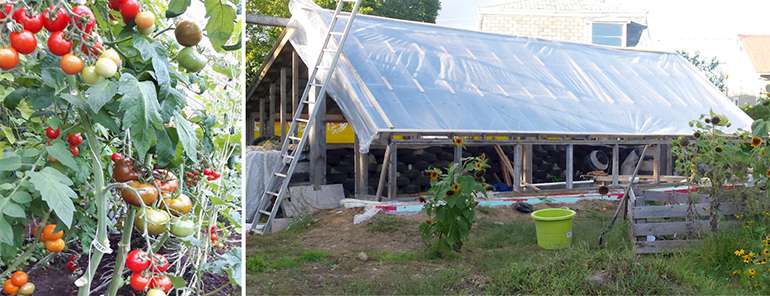
Maude Alary-Paquette – A low-budget greenhouse
Greenhouse construction:
This cold climate greenhouse is 10 x 16 feet, built using a repurposed Tempo Shelter metal frame. All surfaces of the walls and roof are uninsulated and glazed only with polyethylene. The floor is patio stones laid on top of a geotextile membrane. Cedarwood was used for its resistance to rot.
Ventilation:
No ventilation system is in place apart from the windows and polythene walls which are raised during the day to bring in fresh dry air and to avoid overheating.
Growing season:
There is no heating system, so its use is currently limited to the summer months, from the first week of June to as late as mid-October. But the couple would like to add a heat source of some kind to extend the functional use to three seasons.
Type of crop & yield:
Mostly tomatoes, but also peppers, cucumbers, ground cherries, berries, herbs such as coriander and basil. A quarter of the area was reserved for green manure crops. The greenhouse currently provides vegetables for two adults and one child in summer.
"It would be possible to plant successively and grow more vegetables adapted to the cold at the beginning and end of the season, we just don’t have the time. And our growing season in Gaspésie is shorter than in southern Quebec," Maude said.
A few challenges were realized when they first transitioned to growing food in a greenhouse, but Maude says they adapted quickly and found many problems can be solved by regularly opening it up and allowing a change of air.
- The greenhouse impedes visits from a lot of pollinating insects, it also increases the humidity.
- Potential overheating is another factor that requires constant monitoring.
- They are vigilant about keeping it closed up at night to avoid losing the crop to local wildlife.
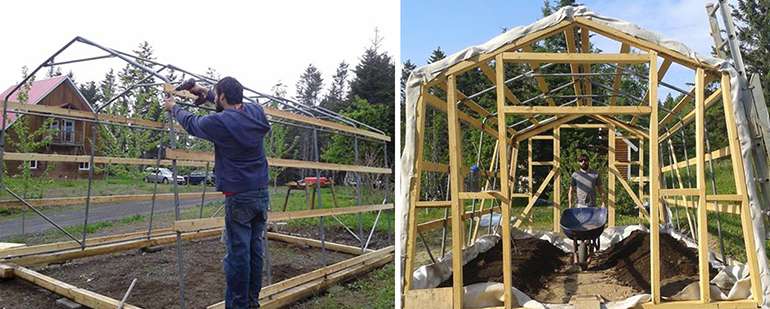
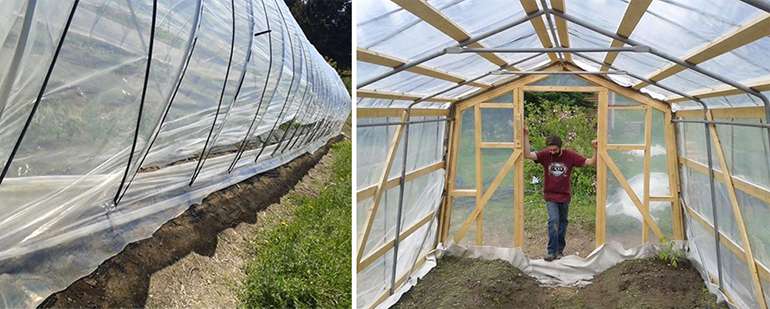
Total material cost:
About $300
Level of satisfaction:
"We love growing our food and the autonomy that comes with it,” Maude says. “Apart from the organic farmer in the neighboring town, it’s a bit of a food desert up here in Gaspésie. I like to know what we are eating, where it comes from and that the food we consume is organic in reflection of our values. Our greenhouse will be a lifelong apprenticeship and a haven of peace!” said Maude.
Maude's goal is to produce enough greens and vegetables to replace the organic local baskets she previously purchased. The greenhouse should be paid in about two years thanks to savings on food purchases.
Recommendations for those who want to get started with a cold climate greenhouse?
Maude first suggests taking the time to track the seasonal sun exposure to help choose the best location. “Don’t build too big if not necessary, and do take the time to process your harvest (cooking, canning and freezing) if everything is ripe at the same time. "It's important to learn about the types of crops you're interested in growing, to reserve a space for green manure, to rotate crops, and so on."
Maude also loves being able to experience the sunshine and warmth in the greenhouse even when it isn’t growing food. "It can be -15 °C outside in February but 10 °C in the greenhouse! On the downside, however, in order to do that, I have to keep the roof and door clear in winter."
Laurent Teasdale & Frédéric Bachand – growing a business in a cold climate
Greenhouse construction:
In order to expand the family business, Teasdale and Bachand bought an old metal greenhouse structure from a retired farmer in the area. The greenhouse they purchased was longer than required and therefore was split into two independent structures.
One of the greenhouses is glazed with a single layer of polyethylene, the other has a double-layered polyethylene fabric with an insulating layer of air in between.
The insulated greenhouse is heated with a reclaimed forced-air furnace that is that activated automatically by a thermostat when the temperature drops below the established threshold. The heating system stops automatically when the control temperature is reached.
Ventilation:
The sides of both greenhouses open as needed to let in the fresh air. The insulated greenhouse also has a thermostat-activated fan that removes heat when the building reaches a set temperature.
Growing season: The heated greenhouse can produce for about three seasons starting as early as April. The uninsulated portion is limited to warmer months only.
Type of crop & yield:
The insulated greenhouse is used primarily for business purposes, growing saffron and paprika. It allows for three-season crops and the sprouting of 10,000 annual seedlings of paprika and saffron which will eventually be planted in fields (approximately 50,000 sq. Ft.) in mid to late June.
The couple uses the other greenhouse for growing vegetables for their own consumption such as tomatoes, cucumbers, cabbages, etc.
Total material cost of greenhouse:
$2500 total for both greenhouses
Irrigation system:
The greenhouse used for food production has an irrigation system with water pumped from a nearby pond. This untreated water is unfit for consumption but perfect for gardening. The other greenhouse and the fields do not have an automated irrigation system.
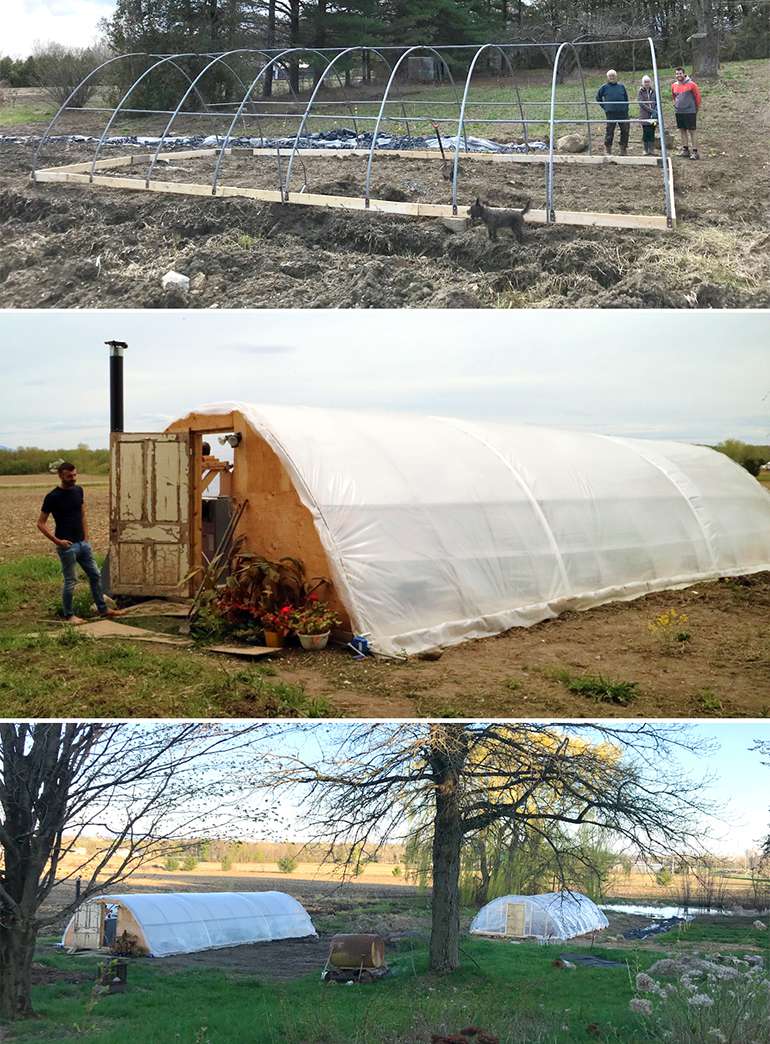
Level of satisfaction with greenhouse:
"We love it because for us it's like an extension of the house since we used to prepare our seedlings in our small attached solarium,” says Laurent.
“We did have some small issues with the furnace in the first year and sometimes the greenhouse was too cold. We have made some adjustments and are hopeful about the coming winter."
And self-sufficiency?
The primary goal of the greenhouse installation was for their business expansion, but on a personal level, they aspire to self-sufficiency, at least during the summer months.
To achieve this, Laurent and Frederic planted several fruit trees and they have a few heads of cattle to produce their own meat. Surplus vegetables are canned or frozen, and those unsuitable for human consumption are used to feed the animals. Animal waste is turned into manure that will be used on the next year of crops.
Recommendations for those who want to get started?
“Be prepared well in advance, and if possible have the greenhouse put up before the cold weather of winter so you are ready to go as soon as the weather warms in the spring.”
“Look for used materials before buying new. It may take some time, but you can often find used greenhouse structures online, as well as old windows and doors. This saves on costs and keeps materials out of landfills. Be sure to compost!”
Source: ecohome.net
